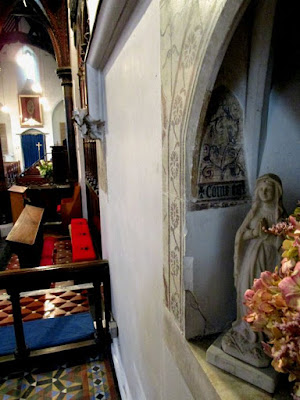St Andrew's was consecrated in 1860, the personal church, really, of Henry Woodyer; it was in some ways a memorial to his deceased wife Elizabeth, and its architect took advantage of the law that stated that anyone could build a new Anglican church if they could get the agreement of the bishop and surrounding incumbents, and fund it. Woodyer was a gentleman architect and I am becoming aware of how important he was to the Anglican Catholic revival in Victorian Surrey. His masterpiece was St Martin's, Dorking, which we've already explored, but he had a hand in the building or restoration of dozens of churches across the county. Woodyer had become a convinced Tractarian while at Oxford University and put his principles into practice whenever he could, in a remarkably advanced form when he got the chance. Externally, St Andrew's looks like a quintessential little English church, with a tiny lych gate and a rambling churchyard: the only clue to anything unusual is the figure of the patron saint over the west door (which you can't normally go through):
But if the interior reminds the visitor a little of St Peter's, Hascombe, this is because Woodyer was also the architect of that amazing church. Grafham is a bit less lavish than Hascombe, but resembles it very strongly, and used to more so before someone whitewashed over the wall-paintings some time after World War Two. The story goes that Bishop Sumner, the Bishop of Winchester at the time and a firm Low Churchman, made it very clear that he disapproved of the use of chancel screens in churches, deeming them 'Popish'. Woodyer got around this by making his screen out of the beam that supports the roof of the church, and mounting the cross above it in the wall. Bishop Sumner turned up to consecrate the church and had no choice but to grit his teeth and get on with it. The amazing reredos, again fitted into the east wall, is just straining to burst out into a canopy over the altar, and one of the unusual features of the church is a series of Victorian banners on theological themes (now heavily restored and mounted in glass cases on the walls) which were supposedly made by 'the females of the Woodyer household' in Grafham Grange next door.
As you can see there is now a little statue of the BVM very discreetly in a niche, and a variety of statuary and stained glass about the place, but surprisingly the Blessed Sacrament isn't reserved at Grafham. It is linked now with Bramley which has also had a Catholic tradition so there is another story to be told there.







No comments:
Post a Comment